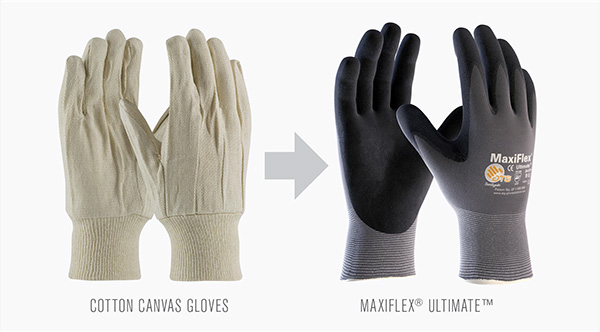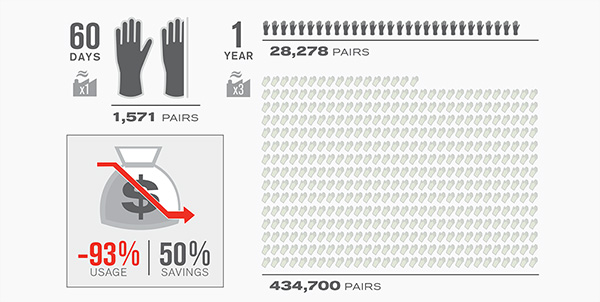Maximizing Efficiency: Managing Waste & Cost
Apr 13, 2016 • WHITE PAPERSProtective Industrial Products

An incredible amount of time and effort is often spent reviewing product pricing over
other considerations that impact a company's bottom line.
Don’t read that the wrong way; while pricing remains important and a price reduction
does produce immediate savings, it doesn’t always translate as the best solution for
cost reduction. One of the most overlooked opportunities for cost reduction is the
management of product usage and waste.
The existence of waste (in one form or another) has been a major factor throughout
the industrial era. It’s even led to the development of multi-million dollar
industries and businesses. Whether it’s ultimately managing costs or increasing
productivity, the reduction of waste in this day and age should be among any
organization’s top priorities.
To demonstrate just how effective the difference can be when addressing waste,
we’ve chosen to use a recent conversion at an American-based company, regarded
as one of the world’s largest metal producers (over $5 billion in sales annually), as
a case study.
THE ANALYSIS
In 2015, a customer reached out to one of our distributors expressing
concern about
their glove usage. The customer was using cotton canvas gloves in three of their
factories.Within these factories, the company refines, converts, and packages finished
goods.
In total, there were approximately 600 employees wearing the cotton canvas gloves
to perform their respective tasks. The annual usage for 2014 was 434,700 pairs of
gloves, which amounted to over $190,000 annually.
THE PLAN
Following a site survey with our distributor, we suggested a switch to
the MaxiFlex®
Ultimate™ as a high quality alternative and set the parameters for the test period.
The customer agreed to convert one of their three factories as a test facility to the
MaxiFlex® Ultimate™ for a 60-day period. In order to isolate and record results as
accurately as possible, a total changeover was requested for the duration of the
testing period. This meant that only the MaxiFlex® Ultimate™ was made available
to the 200 workers at this site.


THE RESULTS
Throughout the 60-day testing period, the test facility used 1,571
pairs of gloves.
When prorated, this volume would be estimated at 28,278 pairs of gloves over a full
year across all three factories. Based on their 2014 usage report, the customer was
using 434,700 pairs of cotton canvas gloves each year. A switch to the MaxiFlex®
Ultimate™ would reduce their product usage by over 93%, or 406,422 pairs of gloves per
year!
When prorating their annual cost with the MaxiFlex® Ultimate™, the customer
calculated they would save nearly 50%. Considering that the customer’s annual
spending on cotton canvas gloves was in excess of $190,000, this is clearly an
immense savings! This savings comes despite the fact that one pair of the MaxiFlex®
Ultimate™ cost nearly 8 times more than a pair of the cotton canvas gloves.

By addressing the product consumption issue head-on, this particular customer was
able to to achieve significant savings, far beyond what a simple price adjustment
would have produced. Even a straight 10% discount, which would have made a
meaningful impact, would have only produced about $19,000 in annual savings,
or nearly 80% less than these actual results.
Why was the difference so dramatic? Seamless coated knits are typically made of
nylon or polyester blends which are much more durable than cotton. In addition,
the incredibly resilient nitrile microfoam coating we recommended can withstand up
to 18,000 cycles on the Martindale Abrasion Test.
ADDITIONAL BENEFITS
In addition to the product savings, the following are a few added
benefits that
that were results of this conversion.
ON-HAND INVENTORY
The significant reduction in usage also allowed this company to reduce the amount of
resources they had tied to their on-hand inventory. A two week supply of the cotton
canvas gloves equated to 16,720 pairs (or over 2 pallets). The cost of this inventory
exceeded $7,300.
Conversely, a two week supply of the MaxiFlex® Ultimate™ is 1,088 pairs (or just 7-8
cases). The cost of this inventory is just over $3,700. The difference: the customer
effectively reduced funds tied up in their on-hand inventory by nearly 50%, while
clearing over two pallets from their storage area.

The distributor also benefited in this aspect, as they were able to clear over 1,500
square feet of warehousing space as a result of the conversion. It took four of the
distributor’s workers several hours to unload each delivery for cotton canvas gloves –
a 20 foot container – and put the product into inventory. This occurred 2-3 times each
year.
REDUCING DOWNTIME
Recalling a previously reported result, this conversion reduced the customer’s annual
usage by 406,422 pairs of gloves per year. The time it takes a worker to remove their
gloves, dispose of them, go to the supply area to get a new pair, put them on, and get
back on the job can be 5 minutes on average.
When these numbers are expanded annually, the reduction in waste would create a time
savings of 2,032,110 minutes. This is the equivalent of over 33,868.5 hours, or over
4,233 eight-hour shifts. That’s like adding the production of 17 full-time, fully
trained employees to the staff!
PRODUCT DISPOSAL
In addition to clearing space and cost within their on-hand inventory, the customer
also reduced their costs for disposing the used products. A 20 yard dumpster can
essentially hold 10 pallets worth of gloves. The reduction in usage means the customer
eliminated a dumpster disposal every 2 - 3 months.
BETTER FIT, FORM AND FUNCTION FOR A SAFER
SOLUTION
Finally, when transitioning from an uncoated glove to a coated glove, one of the
obvious benefits for the wearer is an enhanced grip. In general, the coating will
enhance a glove’s grip by providing friction between the glove and what the worker is
holding, significantly reducing slippage. Different coatings work better given the
working conditions, and the nitrile microfoam coating provided by the MaxiFlex®
Ultimate™ was the ideal solution for the customer’s applications.
Additionally, as we reviewed the customer’s usage reports for both the cotton canvas
gloves and the MaxiFlex® Ultimate™, another benefit presented itself. When the
customer was buying cotton canvas gloves, the only two sizes available to them were
men’s and women’s. The MaxiFlex® Ultimate™ is available in a variety of sizes and the
customer had their employees using everything from XS to XXL, to achieve the proper
fit (the MaxiFlex® Ultimate™ is available in sizes XXS-XXXL).

THE IMPORTANCE OF PROPER FIT
First, a better fit means a safer product. When the glove is too loose, the wearer can
experience less tactile sensitivity and control. This could lead to injuries and
subsequent costs. If the glove is too tight, it can wear faster and provide less
durability while putting additional strain on the wearer’s hands. The poor fit, in
either case, could encourage workers to remove their gloves for certain precision
handling tasks. And the only time a glove can provide the protection it’s designed to
deliver is when it’s being worn!
Second, a better fit will lead to increased productivity. Again, when the glove is too
loose, less control can lead to more distractions and a slower process. A glove that’s
too tight could lead to discomfort and hand fatigue, potentially resulting in the
wearer needing to remove their gloves more frequently. The better fit with the
MaxiFlex® Ultimate™ allowed crane operators – responsible for moving loads in excess
of 200 pounds – to manipulate buttons on the controls, without removing their gloves.
Third, a better fit increases comfort. A properly fitting glove can reduce hand
fatigue and be easier to work with. This can result in workers wearing their gloves
more frequently, if not continuously. Among those who appreciated the change most
during the test period were several individuals who suffered from pre-existing
arthritic conditions. Reinforcing the first point, gloves that are worn and are worn
more frequently can increase the protection of the worker.
SUMMARY
As we summarize all of the data shared, it becomes easier to see just
how impactful
it was for this customer to make the decision to reduce their product usage, as
opposed to negotiating price.

Comparatively, while a price negotiation would have taken less time and delivered a
known outcome, a 10% price reduction would have only saved $19,000.
MORE ARTICLES
Fentanyl in the Workplace: Addressing Occupational Risks and Leveraging the Right PPE
As the opioid crisis continues to cast a long shadow over society, one potent synthetic drug has emerged as a critical player in this devastating epidemic: fentanyl. While its potency has raised co…
READ MOREEvaluating The Benefits Of PIP® 33-115 Reusable Coated Gloves Over Disposable Gloves
INTRODUCTION This case study looks at a comparison between disposable gloves and reusable coated seamless knit gloves for general work applications in industrial and construction site settings. As…
READ MOREEvaluating The Benefits Of Maxiflex® Ultimate™ 34-874 Reusable Coated Gloves Over Disposable Gloves
INTRODUCTION This case study looks at a comparison between disposable gloves and reusable coated seamless knit gloves for general work applications in industrial and construction site se…
READ MOREGloves & Touchscreen Compatibility
TOUCHSCREEN COMPATIBILITY IS NOT SO STRAIGHTFORWARD A big question when selecting work gloves today is touchscreen compatibility. Understanding what constitutes touchscreen compatibility is n…
READ MORERedefining Hand Protection: A New Approach Based on Real Life Use and Risk
Over the years, the industry has struggled to equate cut resistance with actualrisk. The recent updates to the ANSI 105 and EN 388 will provide a more uniformedapproach to assessing the cut resistant …
READ MORE